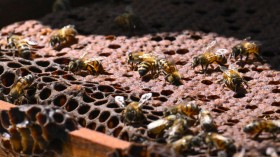If you're ever traveling late at night through the Amazon rainforest, you might find yourself hearing something akin to a pair of tiny horses galloping across the forest floor.
But those aren't miniature ponies you're hearing. It's the sound of a kitten-sized spider stalking prey unfortunate enough to get close to its home.
The aptly named goliath bird eating spider (Theraphosa blondi) is an alarmingly large and hairy tarantula native to the Amazon, stalking the upland rainforest regions of northern South America. Females, who traditionally eat the males after mating, can live for up to almost 30 years and grow to nearly a foot in length. This officially makes them the second largest spiders in the world and arguably the largest by mass.
These giants are so large and hairy that they can even be mistaken for a small mammal, such as a rat or possum.
"First this is what I thought I saw - a big, hairy animal, the size of a rodent. But something wasn't right," entomologist and wildlife photographer Piotr Naskrecki wrote in a recent blog post. "Before that second was over I was lunging at the animal, ecstatic about finally seeing one of these wonderful, almost mythical creatures in person."
Naskrecki, an author of over 30 scientific papers and an avid field-study scientist, had been searching for katydids when he had a rare encounter with a goliath bird eater in the wild. And naturally, he felt compelled to share his adventure - which quickly degraded into a bit of a misadventure - with the world.
"Every time I got too close to the birdeater it would do three things. First, the spider would start rubbing its hind legs against the hairy abdomen. 'Oh, how cute!', I thought when I first saw this adorable behavior, until a cloud of urticating hair hit my eyeballs, and made me itch and cry for several days," he wrote.
He also explained how the tarantula repeatedly "hissed" at him by rubbing microscopic hairs together, and then reared up to display its horrifying and massive fangs - capable of puncturing a mouse's skull.
Amazingly, that first threat, the flinging of bristly hair, is the spider's primary defense, with its huge fangs functioning more as a last resort.
"The venom of a birdeater is not deadly to humans but, in combination with massive puncture wounds the fangs were capable of inflicting, it was definitely something to be avoided," the entomologist wrote.
His first encounter occurred several years ago, but Piotr decided to share his story after running into another of the massive spiders just last week. Now, he says, he knows how to handle them better.
"It's just another Goliath birdeater," he said. "Aren't you a cutie pie?"
© 2024 NatureWorldNews.com All rights reserved. Do not reproduce without permission.





